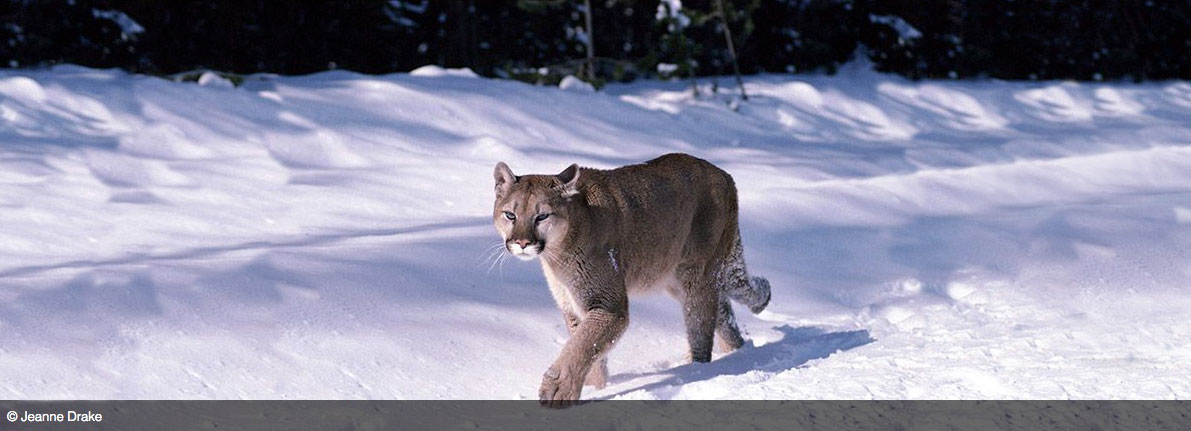
Photo: Jeanne Drake, courtesy Cougar Network
If you see a mountain lion, do not run. Do not surprise the mountain lion. Make noise to ensure that the animal is aware of your presence. A mountain lion is not likely to attack a person unless it feels trapped or provoked or if you appear to be prey (which is why you should not run). If you are in a group, gather everyone together if possible and move as a group.
Respect the mountain lion’s space, and do not approach the animal. If the mountain lion sees you, stand your ground; look as large as possible by standing up straight and putting your arms up in the air and slowly back away. If possible, go inside a building or get into a vehicle. If a mountain lion makes contact with you, always try to fight it off. Throw rocks, use sticks. Do not play dead.
Mountain lions, also known as cougars or pumas, have a tan or tawny coat, with white or cream-colored chin, undersides, and inside of legs. The ears are rounded, and the back of the ears are solid black to dark gray. The tail is long (up to half the total body length), thick, and tipped with black. Mountain lions less than a year old have dark brown spots.
Average Length: 60 to 95 inches
Average Height: 27 to 31 inches at the shoulder
Average Weight: 115 to 160 pounds (adult male); 75 to 110 pounds (adult female)
Mountain lion tracks are round in shape, typically 3 to 4 inches in length and 3 to 4½ inches wide. They walk with their claws retracted (pulled in), so if the track has claw marks then it is not a mountain lion track. Inexperienced observers often mistake the tracks of coyotes or large dogs for mountain lion tracks. The diagram below points out easy ways to tell the difference between mountain lion and dog tracks.
Mountain lions are typically very elusive, so most sightings last only a few seconds. In Illinois, domestic dogs, domestic cats, and bobcats (Lynx rufus) are the animals most commonly misidentified as mountain lions.
In addition to their large size, there are several distinguishing features of mountain lions that can help in positively identifying them. The chart below highlights the differences between the species most commonly mistaken for mountain lions.
| Description | Mountain Lion | Bobcat | Dog |
| Weight (adult) | 75 to 240 pounds | 10 to 40 pounds | 20 to 180 pounds |
| Length (adult) | 60 to 100 inches | 30 to 35 inches | 25 to 60 inches |
| Height at shoulder (adult) | 27 to 31 inches | 20 to 23 inches | 10 to 26 inches |
| Color | Solid tan with cream undersides (young have dark spots) | Tan with cream undersides; adults and young have dark spots (may not always be visible on adults) | Variable fur color |
| Face | Round face; short muzzle; no fringe of fur | Fringe of fur makes face appear rounded; short muzzle | Round to long face; elongated muzzle |
| Ears | Erect; Rounded; no ear tufts; backside of ear dark with no white spot | Erect; tufts make ears appear pointed; backside of ear dark with white spot | Erect or floppy; variable ear shape and color |
| Inner legs | Cream-colored; no spots | Cream-colored; dark spots visible | Variable fur color |
| Tail | 21 to 35 inches; carried low with curl at tip | 5 to 6½ inches; carried close to body | 3 to 12 inches long; often curved upward |
| Tracks | 3 to 4 inches; no claw marks | 2 to 2½ inches; no claw marks | 2 to 3 inches; claw marks |
There have been eleven confirmed mountain lions in Illinois between 2002 and 2025. A mountain lion was killed by a train in Randolph County in 2002. Another mountain lion was killed by a bow hunter in Mercer County in 2004. In April 2008, a mountain lion was shot and killed in the Roscoe Village neighborhood in Chicago. All of these were sub-adult (2 to 3 year old) males. DNA analysis indicated that these animals were genetically similar to mountain lions from South Dakota and strongly suggests that these were all wild males dispersing from that western population.
Images taken by trail cameras in Jo Daviess County in September 2012 and in Morgan, Pike, and Calhoun counties in October and November 2012 were confirmed by the Illinois Department of Natural Resources (IDNR) to show a live mountain lion. Given the long distances typically traveled by mountain lions and the proximity of the counties (especially Calhoun, Morgan, and Pike), it is possible that the camera images may have shown the same mountain lion.
A mountain lion was killed by Illinois Conservation Police at a farmstead in Whiteside County in 2013.
In November 2014, trail camera images taken in Sangamon and Effingham counties were confirmed by the IDNR to show a mountain lion. The distances and chronology of the images suggest that they may have shown the same animal.
There was a confirmed sighting of a mountain lion captured on a trail camera on private property in Whiteside County on September 28, with field confirmation on September 29, 2022. IDNR experts believe it may be the same mountain lion that was struck and killed in DeKalb County on I-88 on October 16, 2022. That mountain lion was transferred by the Illinois State Police to an IDNR wildlife biologist and was then delivered to the University of Illinois Champaign-Urbana for a full necropsy and DNA analysis. The University of Illinois analysis will provide valuable information to biologists about the animal, its place of origin, and exploratory movements of mountain lions across the Midwest.
In October 2022, the IDNR was monitoring another mountain lion reported in western Illinois. This animal had a GPS collar that was originally attached in November 2021 by the Nebraska Game and Parks Commission (NGPC) as part of an ongoing research project on their mountain lion population, including movement patterns. The young male mountain lion made its way to Springfield, where it was determined that the animal may pose a potential threat to people or property. The mountain lion was sedated by staff with the U.S. Department of Agriculture’s Wildlife Services and sent to the Exotic Feline Rescue Center in Center Point, Indiana.
During October 2023, IDNR monitored reports of a mountain lion in Schuyler, Scott, and Morgan counties in western Illinois. The animal was photo-documented on trail cameras on private properties on October 19 & 20, 2023. The animal was previously documented moving westward across southern Iowa (October 9-11, 2023) prior to crossing into western Illinois. Field confirmation of the animal by IDNR/USDA staff was completed on private property in Schuyler county on October 25, 2023. Late November of 2023, IDNR monitored additional sightings of a mountain lion along the Greene/Jersey county line. A follow-up site investigation was conducted by IDNR staff and the animal recorded as a verified sighting in IDNRs large carnivore sighting database. It is unknown whether the October and November sightings are of the same animal.
In April 2025, IDNR monitored reports of a mountain lion in Pike County, on the western border of Illinois along the Illinois River. The animal was first photo-documented on private property in that area on 9 April 2025. The animal was recaptured on camera on 11 and 12 April 2025 traveling north along the Illinois River. On 13 April 2025 the animal was photo-documented back on the same private property that it was initially detected. On 16 April 2025, a site investigation was conducted by IDNR/USDA staff to confirm positive species identification. On 20 April 2025, the animal was detected on camera in Calhoun County ~3.5 miles east of the location where it was initially observed. There have been no reported sightings of the animal since, however; IDNR will continue to monitor future movements via additional trail camera photos or reported sightings from the public in Pike/Calhoun or adjacent counties in the days ahead.
Mountain lions were eliminated from Illinois before 1870 due to habitat loss and hunting pressure. In the last several years there have been confirmed sightings of individual mountain lions moving through the state. There is no evidence that resident breeding populations of mountain lions exist in Illinois at this time. As populations in South Dakota, Nebraska, and Rocky Mountain states increase, it is possible that mountain lions will disperse through Illinois in search of new territories.
Mountain lions have been protected in Illinois since 2015. Mountain lions may not be hunted, killed, or harassed unless there is an imminent threat to person or property. If you feel that your person or property is being threatened, contact the IDNR to learn about options available to address potential threats. The IDNR may assist you with control measures.
If you have recently seen a mountain lion in Illinois, please report the sighting to the Illinois Department of Natural Resources.
Reviewable evidence is very helpful during efforts to identify the animal and the location. Please provide any documentation, including original images of individual animals or tracks that you were able to obtain. When documenting tracks or other signs, be sure to photograph individual tracks as well as groups of tracks. Include in the image an object to aid in the determination of size including a ruler, tape measure, or common object of standard size (coin or paper money, business card, etc.). Also include images of the wider area where the tracks were found, including the tracks as well as local features that can be located if the tracks are destroyed.
An IDNR biologist will review the information provided and attempt to use it to confirm the species and location of the sighting.
Wisconsin Department of Natural Resources: Cougars in Wisconsin
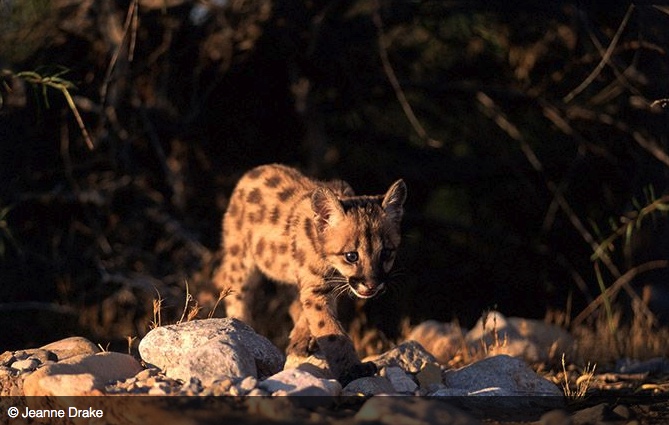
Photo: Jeanne Drake, courtesy of Cougar Network
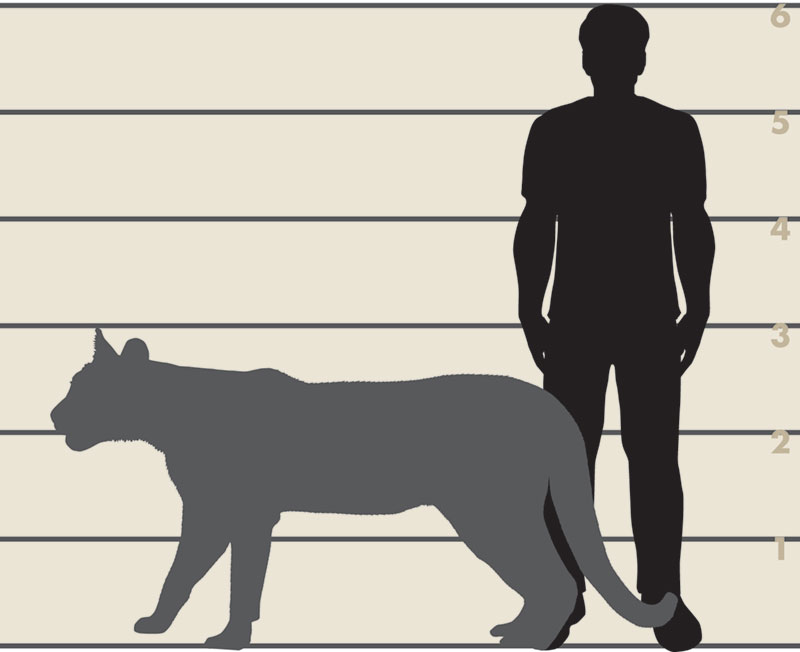
Illustrator: Lynn Smith
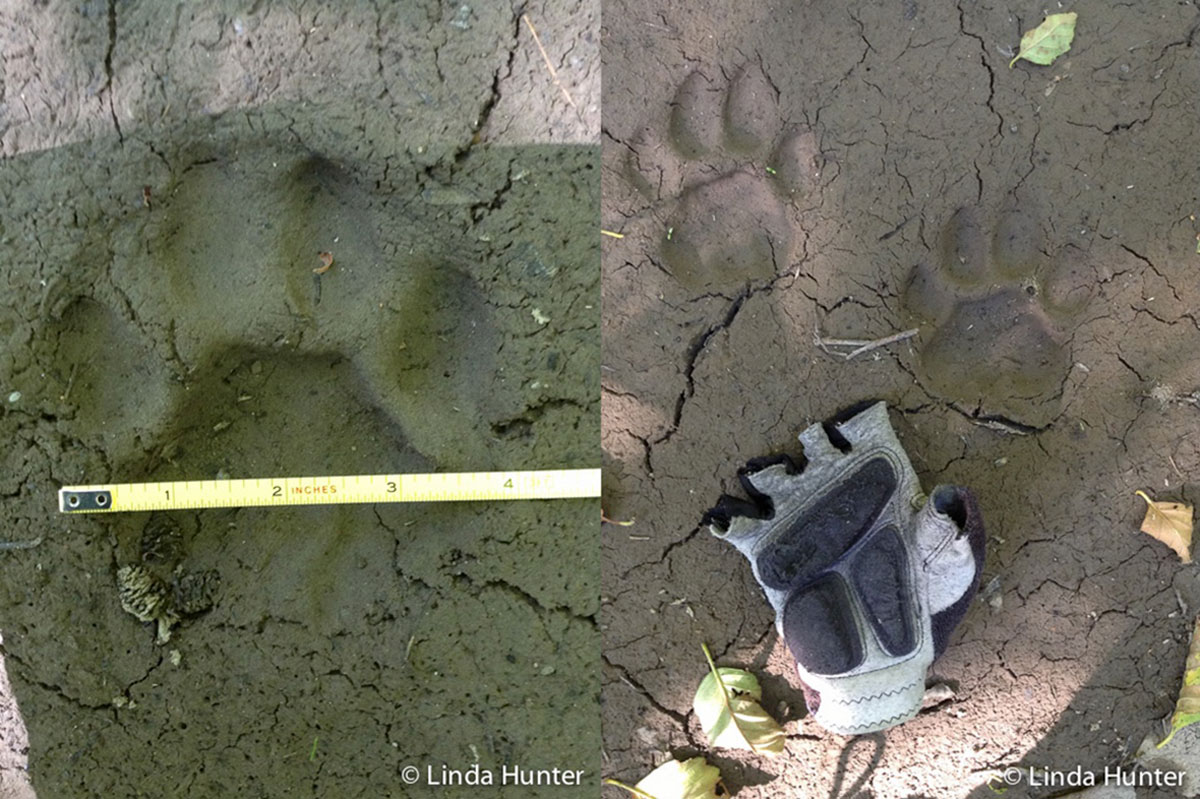
Photos: Linda Hunter
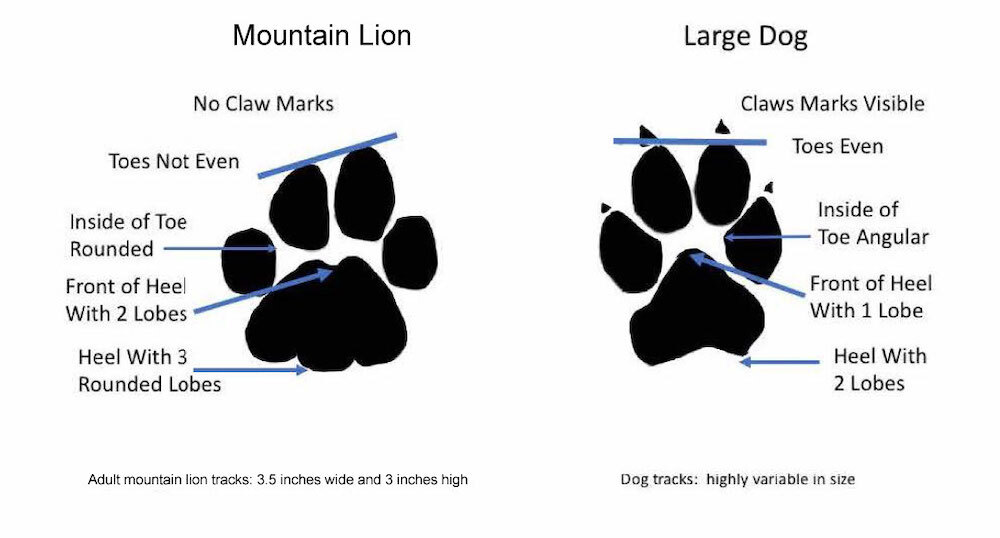
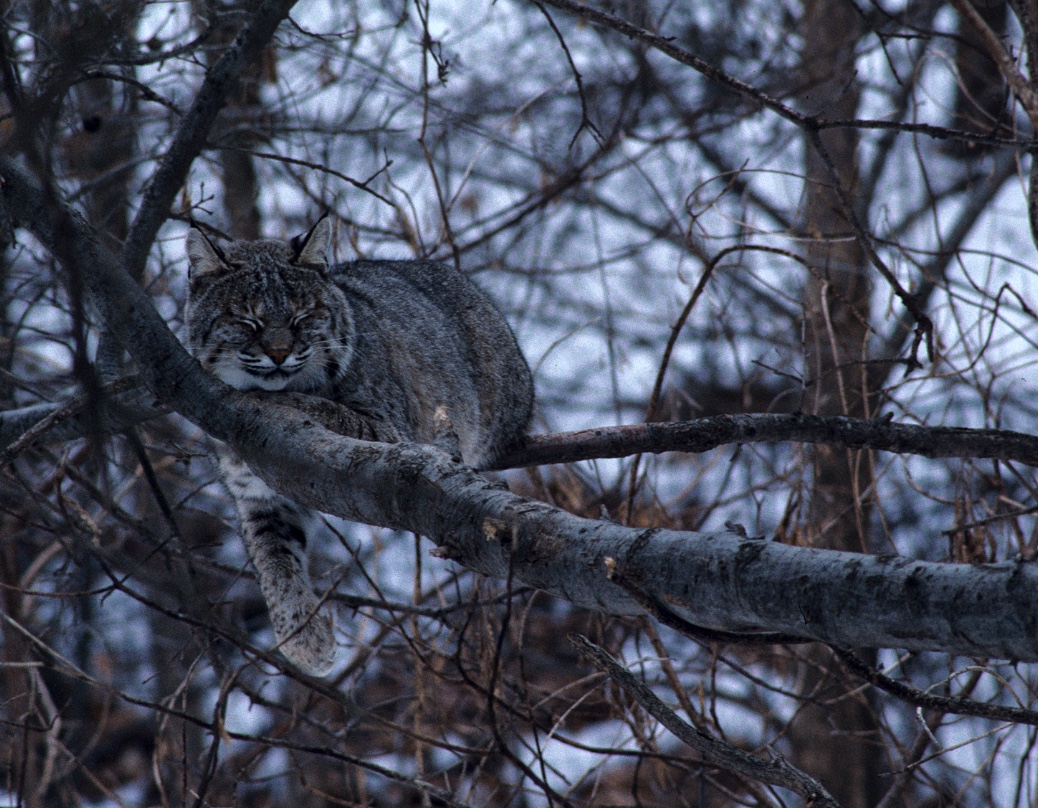
Photo: Michael Jeffords
The Wildlife Illinois website was authorized by the Illinois Department of Natural Resources (IDNR) in partial fulfillment of project W-147-T. The website was developed by the National Great Rivers Research and Education Center, 2wav, and the IDNR in partnership with the United States Department of Agriculture Animal and Plant Health Inspection Service Wildlife Services and University of Illinois Extension to provide research-based information about how to coexist with Illinois wildlife.